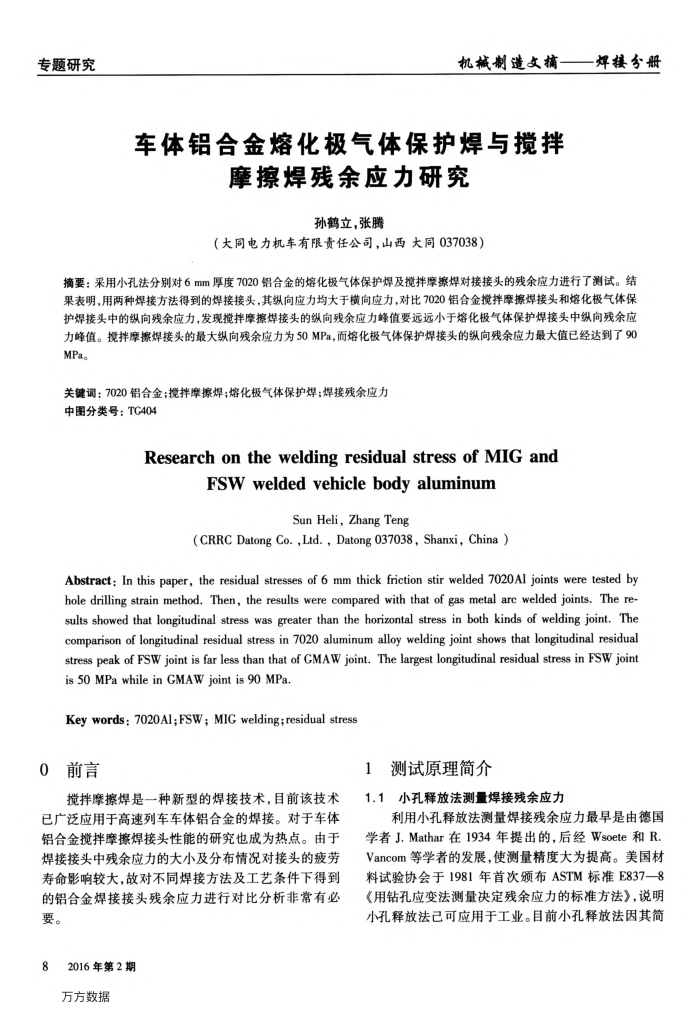车体铝合金熔化极气体保护焊与搅拌摩擦焊残余应力研究
内容简介
 专题研究
专题研究机械制造文摘一焊接分册
车体铝合金熔化极气体保护焊与搅拌
摩擦焊残余应力研究
孙鹤立,张腾
(大同电力机车有限责任公司,山西大同037038)
摘要:采用小孔法分别对6mm厚度7020铝合金的熔化极气体保护焊及搅拌摩擦焊对接接头的残余应力进行了测试。结果表明,用两种焊接方法得到的焊接接头,其纵向应力均大于横向应力,对比7020铝合金搅拌摩擦焊接头和熔化极气体保护焊接头中的纵向残余应力,发现搅拌摩擦焊接头的纵向残余应力峰值要远远小于熔化极气体保护焊接头中纵向残余应力峰值。搅拌摩擦焊接头的最大纵向残余应力为50MPa,而熔化极气体保护焊接头的纵向残余应力最大值已经达到了90 MPa。
关键调:7020铝合金;搅拌摩擦焊;熔化极气体保护焊;焊接残余应力中图分类号:TG404
ResearchontheweldingresidualstressofMIGand
Fswweldedvehiclebodyaluminum
Sun Heli, Zhang Teng
(CRRC Datong Co.,Ltd., Datong 037038, Shanxi, China)
Abstract: In this paper, the residual stresses of 6 mm thick friction stir welded 7020Al joints were tested by hole drilling strain method. Then, the results were compared with that of gas metal arc welded joints. The re-sults showed that longitudinal stress was greater than the horizontal stress in both kinds of welding joint. The comparison of longitudinal residual stress in 7020 aluminum alloy welding joint shows that longitudinal residual stress peak of FSW joint is far less than that of GMAW joint. The largest longitudinal residual stress in FSW joint is 50 MPa while in GMAW joint is 90 MPa.
Key words: 7020Al;FSW; MIC welding;residual stress
0前言
搅拌摩擦焊是一种新型的焊接技术,目前该技术已广泛应用于高速列车车体铝合金的焊接。对于车体铝合金搅拌摩擦焊接头性能的研究也成为热点。由于焊接接头中残余应力的大小及分布情况对接头的疲劳寿命影响较大,故对不同焊接方法及工艺条件下得到的铝合金焊接接头残余应力进行对比分析非常有必
要。 8
2016年第2期万方数据
1测试原理简介
1.1小孔释放法测量焊接残余应力
利用小孔释放法测量焊接残余应力最早是由德国学者J.Mathar在1934年提出的,后经Wsoete和R. Vancom等学者的发展,使测量精度大为提高。美国材料试验协会于1981年首次颁布ASTM标准E837—8《用钻孔应变法测量决定残余应力的标准方法》,说明小孔释放法已可应用于工业。目前小孔释放法因其简